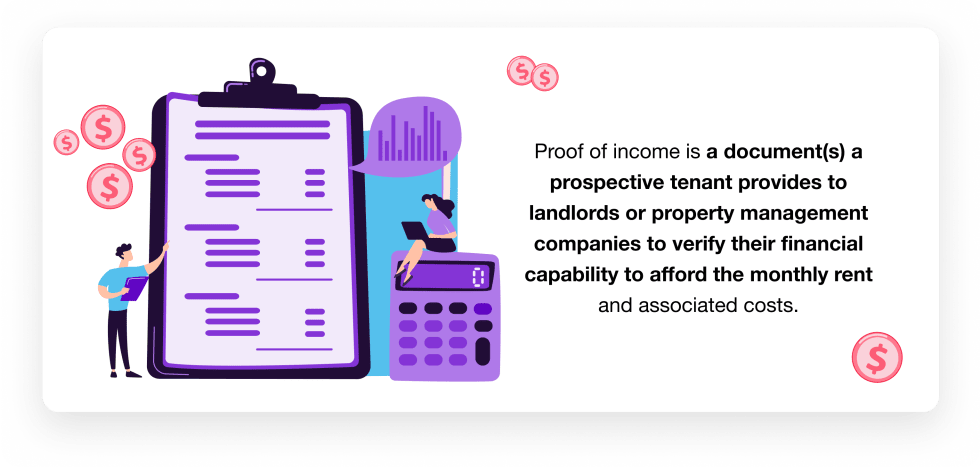South Bank at Quarry Trails
- 94 units available
- Studio • 1 bed • 2 bed • 3 bed
- Amenities
In unit laundry, Patio / balcony, Granite counters, Pet friendly, Stainless steel, Walk in closets + more

Pay stubs aren’t the only way to prove income. Whether you’re a freelancer, gig worker, or full-time employee, here’s how to show landlords you can afford the rent.
Falling behind on rent is more common than you might think. More than 5 million households are behind on rent payments, and a recent report by the Consumer Financial Protection Bureau found that nearly one in four renters incurred late fees during 2023.
As part of the rent application process, landlords and property managers want to know whether potential tenants can afford to pay rent. Enter proof of income requirements.
Whether it’s a pay stub, a tax return, or a platform payout summary, proof of income is the documentation that shows a prospective tenant can handle the monthly rent and related costs.
In today’s competitive rental market, submitting the right paperwork up front can make the difference between landing your next apartment and watching it go to someone else.
To make the process easier, we’ve rounded up 18 ways to prove your income in 2025, covering everything from traditional employment documents to side hustles, reselling platforms, and even content creator payouts for rental application purposes.

Pay stubs are the most direct way to prove income. They should include your name, employer, pay period, gross and net income, hourly rate or salary, and the frequency of payment. \
Tip: Bring at least your two most recent pay stubs. Make sure the employer’s name matches what you list on your rental application.
A completed 1040 tax return shows your total income over the past year. Landlords usually want more than a tax form because it only proves your income from the previous year. Your landlord will still need to verify your current job and salary status to ensure an accurate report.
Tip: Supplement your 1040 with proof of current-year income (such as bank deposits or a profit and loss statement).
Bank statements are commonly used by self-employed renters or those with gig income. Without a traditional source of income, landlords need a better idea of how much you really earn. Remember that a bank statement only details the amount of money you deposit into the account and the amount withdrawn.
Tip: Submit three to six months’ worth of statements. Highlight recurring income deposits. If necessary, include an annotation or summary.
Your employer can provide a proof-of-income letter that says how much you make. If you’ve recently started a job and don’t have a pay stub yet, ask for a signed income verification letter. After providing the documentation, your landlord may still want a copy of your pay stub when you receive it.
Tip: The letter should be on company letterhead and include your job title, salary/hourly rate, start date, and contact information for your employer or HR department.
Income from alimony, child support, or legal settlements is considered a valid form of regular income as long as it’s documented.
Tip: Provide the official court order and a bank statement showing recent payments. If you’ve lost the court paperwork, request a copy from the court clerk.
Social security income can be submitted as proof to your landlord or property manager. You'll need a letter or other documentation that details your monthly benefits. Tip: Provide the official award letter showing the weekly benefit and duration. If you don’t have one handy, you can also request one online here.
Unemployment assistance from getting laid off is also verifiable income. Contact the unemployment office in your county to ask for an unemployment compensation letter.
Tip: Provide the official award letter showing the weekly benefit and duration. Be upfront about your employment search if asked.
Pensions are a reliable, fixed-income source for retirees. Most providers issue monthly or annual statements. Landlords may still ask for a tax Form 1099-R to verify your annual pension distribution income.
Tip: Include a recent 1099-R tax form or a monthly benefits letter, plus bank deposits to verify payments are ongoing.
Getting laid off or leaving your job isn't always a deal-breaker for landlords. If you're no longer employed but received severance, it may serve as your income and help you qualify temporarily.
Tip: Submit a formal letter from your employer outlining the total amount and duration of severance payments.
Disability insurance benefits are not classified as income for tax-reporting purposes, but they can be used to demonstrate payment capacity, especially for long-term claims.
Tip:** Ask your insurance provider for a benefits summary letter. Pair it with a recent bank deposit screenshot.
Injury on the job may lead to a workers' compensation claim. Proof of payout is accepted if it replaces your regular income due to a work-related injury.
Tip: Provide the court or insurer award letter, including the payment amount and coverage period.
A W-2 is used for tax purposes but also summarizes your annual employment earnings and is helpful alongside pay stubs. If you have multiple employers, your landlord may want to see a W-2 from them.
Tip: If you’ve changed jobs recently, clarify which W-2 corresponds to which employer and support with recent stubs.
1099-NEC or 1099-K forms are often issued to gig workers, freelancers, contractors, and platform sellers who earned more than $600 from a single client. It lists all your income over the past year and details how much tax you pay on that income.
Tip: If you didn’t receive a 1099, provide client invoices, payment confirmations, or platform earnings dashboards.
Regular payments from annuities or insurance payouts can qualify as proof of income. An annuity statement helps a landlord understand how much you receive from an insurance company.
Tip: Submit the annuity agreement or a payout schedule showing monthly disbursements.
If you have investments, you can also provide documentation regarding your dividends or distributions. Your landlord may also ask for your 1040 to verify they were reported and check other areas of your income and bank statements to prove your financial stability.
Tip: Include a 1099-INT or 1099-DIV form plus portfolio statements and bank deposit history.
Bonus and incentive payments can significantly impact your income. If the income requirement is above your base pay, include any bonus or incentive pay statements during the apartment income verification process to boost your chances.
Tip: Include a bonus payout letter from HR, along with three to six months of pay stubs and bank deposits that show recent incentive payments.
If you earn money reselling goods online, that income can help demonstrate your ability to pay rent. Annotated monthly summaries or spreadsheets showing steady monthly earnings can help show that you more than meet the income requirements.
Tip: Submit platform dashboards, 1099-K forms (if issued), and bank statements showing payouts.
As earnings through platforms like TikTok Shop, Instagram, YouTube, or affiliate marketing become more common, you can use platform payout reports as verifiable income.
Tip: Provide 1099-K/1099-NEC forms, and bank deposits to verify your income, including a short explainer on the type of earnings (e.g., brand deals, affiliate income).
| If You Have | But Not | Try This Instead |
|---|---|---|
| 1099 forms from gig work | Recent pay stubs or W-2s | Bank statements showing consistent deposits + screenshots from platform dashboard |
| New job offer letter | Pay history | Ask HR for a written salary breakdown + submit a letter on official letterhead with contact info |
| Social Security or disability benefits | Traditional job income | Benefits letter from the Social Security Administration + a recent bank statement showing deposits |
| Child support or alimony | Court documentation | Copy of the order from the courthouse or your lawyer + show payment history in bank account |
| Seasonal income | Consistent monthly deposits | Combine tax return + annotated calendar of work periods + client references if possible |
| Cash income | Employer documentation | Provide notarized letter explaining cash income + consistent deposit record in bank statements |
| Freelance or consulting income | 1099 forms (not issued) | Invoices + client payment screenshots + bank deposits with memo line evidence |
| Investment income | Employment income | Include interest/dividend statement + last year’s 1040 + current portfolio summary |
| Severance | Current job | Severance agreement + deposit confirmation + plan for when payments end |
| Income from reselling | Formal business docs | Sales dashboards + 1099-K from platforms (if applicable) + bank deposits from sales |
The 1099-K is a tax form for sellers or gig workers who make $5,000 or more per year on platforms like eBay, YouTube, and Etsy:
| Platform | 1099-K Threshold | What’s Reported | What You Can Use |
|---|---|---|---|
| eBay | $5,000 or 200+ transactions | Gross sales | 1099-K + payout reports + bank records |
| Poshmark | $5,000 | Gross income | Sales summary + 1099-K (if issued) |
| Mercari | $5,000 | Gross income | Sales dashboard + deposits |
| Etsy | $5,000 | Gross receipts | Shop finances + 1099-K |
| Facebook Marketplace | $5,000 via Stripe | Gross sales | Stripe 1099-K + payout records |
| PayPal/Venmo (business) | $5,000 | Tagged business income | CSV export + bank match |
| TikTok Shop | $5,000 or 200+ transactions | Gross sales/commissions | TikTok Seller Center payout reports + 1099-K |
| Instagram/Meta Payouts | $600 in some states (1099-NEC/1099-K) | Ad share, subscriptions | Meta Creator Studio payout summary + 1099-NEC |
| YouTube Partner Program | $600+ (1099-NEC via AdSense) | Ad revenue, memberships | AdSense 1099-NEC + YouTube Studio reports |
| Affiliate Networks (Amazon, ShareASale, etc.) | $600+ (1099-NEC) | Commission earnings | Network payout reports + 1099-NEC |
Note: For 2025, the federal threshold for 1099-K reporting remains $5,000 (or 200 or more transactions). However, some states—Massachusetts, Vermont, Virginia, and Illinois—require platforms to issue 1099-K forms for $600 or more in gross payments. Renters in those states may receive forms even if their income is below the federal level.
The rule of thumb is not to spend more than 30% of your monthly income on rent. Your household income should also be two to three times your monthly rent. For example, if your rent is $1,000 per month, your landlord will likely expect you to earn around $3,000 per month to comfortably afford your rent. However, if you live in an expensive area like New York City, it's common for new renters to pay much more.
The Apartment List rent calculator is a valuable tool that'll help you calculate the amount you can comfortably afford for monthly rent payments.
**Use this checklist before you apply:
As you now know, there are several examples of proof of income. Additionally, the following are some tips regarding apartment rental income requirements and understanding what qualifies as proof of income.
If you have a problematic financial or rental history, it is essential to come as prepared as possible. Your organization, documentation, and explanation of any issues will go a long way to win over a landlord or property manager.
Now that you have everything you need to show proof of income for your apartment, it’s time to start your apartment hunt. If you’re worried that your finances don’t make the cut, consider a short-term apartment or a for-rent-by-owner apartment. There’s always a way to find an apartment that works for you, regardless of your past finances or proof of income track record.
Ready to find the perfect place for you? Sign up for Apartment List to find your next apartment.
Verifiable monthly income is income that can be supported with documentation—such as pay stubs, tax returns, or benefit letters—and shows that you can reliably afford your rent. Landlords typically want to see a stable income, typically totaling two to three times the monthly rent, to support the income listed on your apartment application.
There are many alternatives to pay stubs, including tax returns, bank statements, employer income letters, 1099s, Social Security statements, court-ordered payments, unemployment benefit letters, annuity statements, interest and dividend income statements, and bonus/incentive payout records. For gig or side hustle work, use earnings dashboards and bank deposits as proof of income.
A proof of income letter is an official document from an employer verifying your income, salary or hourly wage, job title, start date, and employment status. It’s often used when pay stubs are unavailable, such as at the start of a new job. This letter confirms that you are currently employed at a specific company and provides your salary information. To obtain a proof of income letter, you will need to speak directly with your employer.
A proof of income letter should include the following:
Use 1099s, client invoices, bank statements, and bookkeeping software summaries. If possible, pair documents to show both income earned and deposited.
Yes. Submit platform earnings dashboards, 1099-Ks or 1099-NECs, and bank statements showing consistent deposits.
Yes. Include sales reports, 1099-K (if issued), and bank statements. A spreadsheet summary or screenshots from your seller dashboard can also help to show steady sales.
By providing payout summaries from TikTok, Instagram, YouTube, or affiliate networks, along with 1099 forms and matching bank deposits. A brief note on how they earn (ads, sponsorships, product sales) can add clarity.
Ask your employer or HR department for a proof of income letter that outlines your salary, position, and start date.
Provide three to six months of bank statements to show an average income. Add a brief written explanation if income is seasonal or client-based.
Try these options:
Use a combination of pay stubs (if tips are reported), point-of-sale summaries, employer letters estimating average tips, and bank statements showing regular cash or direct deposits. A written estimate of average weekly tips, especially when supported by consistent deposits, can also be helpful.
Income documents contain a lot of sensitive personal information, so it's normal to be concerned about privacy. To protect yourself:
Income verification is an important part of the process, but your data privacy matters too.
To protect your sensitive financial information while still providing the necessary details, you should black out the following on your bank statement:
Blacking out this information allows you to retain your financial privacy while still providing the landlord with the necessary proof of income and financial stability.
While your credit score doesn't directly reflect your income, it does help demonstrate your history of managing money responsibly. A higher credit score—most ask for 580 and above—can reassure landlords that you’re likely to pay rent on time. You can also include a rent reporting service like RentReporters and Boom that adds your on-time rent payments to your credit history.



In unit laundry, Patio / balcony, Granite counters, Pet friendly, Stainless steel, Walk in closets + more
In unit laundry, Granite counters, Hardwood floors, Dishwasher, Pet friendly, 24hr maintenance + more